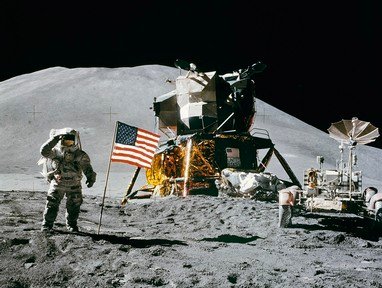Quiz Answer Key and Fun Facts
1. "Pete" Conrad, the commander - you could say he was in charge - of Apollo 12, was the third man on the moon. What was his real first name?
2. Alan Bean, the lunar module pilot for Apollo 12, landed his craft in the largest lunar "sea" - so large it is named in a unique way for a "sea". What is it called, despite being peaceful?
3. The commander of Apollo 14 was the oldest of the Apollo astronauts and the only one of NASA's original Mercury 7 to make it to the lunar surface. He was the fifth man on the moon, but "fore" comes to mind! Who was he?
4. Edgar Mitchell was the sixth man on the moon. After watching his co-astronaut's golf drives he improvised with a metal rod to show his javelin skills.
5. The commander of Apollo 15 was from San Antonio, Texas, although his surname suggests he came from the UK. Who was he?
6. The eighth man on the moon, James Irwin had his religious faith strengthened by the experience, and later led expeditions to Mount Ararat in search of what?
7. The commander of Apollo 16, John Young was the only astronaut to pilot or command four types of spacecraft: Gemini, Apollo Command/Service Module, Apollo Lunar Module and which other?
8. The tenth man to walk on the surface of the moon was the youngest of all 12 Apollo moonwalkers. He had an MSc from MIT, but his surname was that of another university. What was his name?
9. The commander of Apollo 17 was the eleventh man to walk on the moon and he was the last to leave the lunar surface at the end of the visit in December 1972. What was his name?
10. Harrison Schmitt was the twelfth and final astronaut to walk on the moon. He was unique among the 12 because he wasn't selected because of his experience as a pilot.
Source: Author
Upstart3
This quiz was reviewed by FunTrivia editor
gtho4 before going online.
Any errors found in FunTrivia content are routinely corrected through our feedback system.


